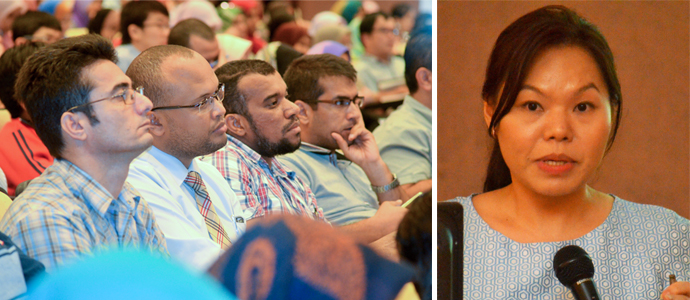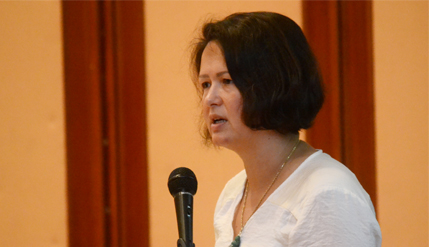Tips On How To Get Articles Published
Pix Muhamad Ikhwan Zulhimi and Nur Farhana Othman (UiTM Intern)
BANGI, 28 August 2014 – Academics from The National University of Malaysia (UKM) were today given insights into how to write articles that can readily be accepted by journals even the high impact ones.
Two consultants from Elsevier, a world-leading provider of information solutions, Dr Valerie Teng-Broug, a Journal Publisher for Elsevier and Ms Elise Shen, a Solution Consultant for Elsevier Singapore gave tips on how best to write such articles at a Publishing Workshop 2014 at The National University of Malaysia here today.
The workshop “How To Write A Great Research Paper and Get It Accepted By A High Impact Journal” was organised by the Tun Sri Lanang Library (PTSL) of UKM and Elsevier. It was held at the Tun Abdullah Mohd Salleh Complex and officially opened by Deputy Vice-Chancellor (Research and Innovation Affairs) Prof Dato’ Dr Mazlin Mokhtar.
Elsevier is a world-leading company that provides information solutions that enhances the performance of science, health and technology professionals, empowering them to make better decisions, deliver better care and sometimes make ground-breaking discoveries that would advance the boundaries of knowledge and human progress.
It provides web-based, digital solutions and among them are ScienceDirect, Scopus, Elsevier Research Intelligence and ClinicalKey. Elsevier also publishes nearly 2,200 journals, including The Lancet and Cell, and over 25,000 book titles, including a number of iconic reference works.
In giving her tips, Dr Teng-Broug said everything from the abstract of the article, correct use of language to choosing the right journal are important factors in getting an article published.
Dr Valerie said those submitting articles for publication must remember that they are competing with 1.4 million other articles to be chosen. Many first-time authors will find it hard to have their articles skimmed through by editors mush less accepted.
First time authors make the mistake of choosing only the top journals to send their articles for publication. Describing it as their first stumbling block, she said top journals receive thousands of articles each year, where 99 percent are rejected.
She said the abstract of any article is most important and authors needed to take time to make their abstracts clear and concise. An abstract should give an insight to what the article is about.
The introduction and conclusion of an article should also be strong as it defines the work and gives it justification. Authors should also make use of graphs and charts since an image or picture would relay the message better than a full paragraph of words, she said.
Use short and simple sentences instead of long and philosophical renderings. Nevertheless scientific or technical jargon or terms needed to be explained carefully and clearly to enable the editors and readers understand what is written.
“You’re not writing Shakespeare; don’t use flowery words and long sentences. So it is not a problem even if English is not your main language. Your articles are for scientific, technical and medical journals. Use simple English and short sentences so that the message gets across”.
Ms Elise said language is the main problem faced by editors. Her advice is to use only clear and correct language with one idea per sentence. The level of English needed in an article must be comprehensible and structurally correct.
Her advice is not to send articles that have bad English and terrible grammar, as Editors will complain and reject their work. Simple grammar mistakes and other language errors are usually not corrected by the editors.
This is because, certain words in those articles are technical jargon that only the author or a person specialised in that field would know. As editors they are not experts in the scientific field and to correct it without knowing what it is, may change the meaning of the sentences and the article completely. That would reflect badly on the author, she said.
Another mistake that authors should not do is to use too much references and avoid as much as possible giving reference to the authors own previous works, Ms Elise said.
![]()



